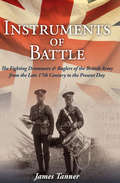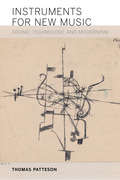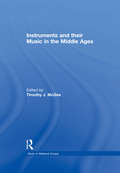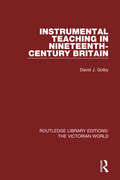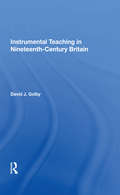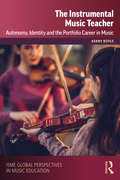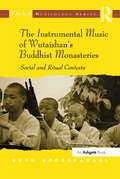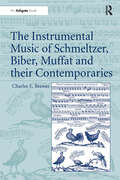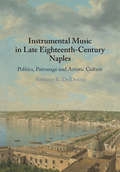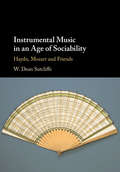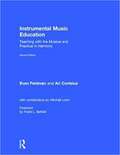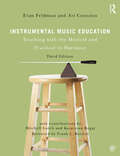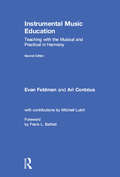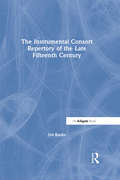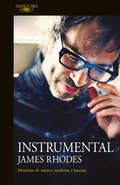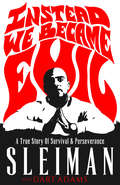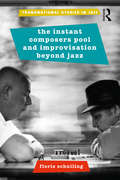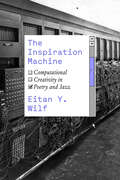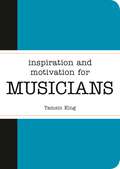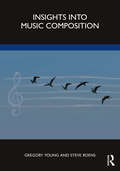- Table View
- List View
The Instruments of Battle: The Fighting Drummers and Buglers of the British Army from the Late 17th Century to the Present Day
by James Tanner“The hitherto forgotten story of the development of the regimental band, mainly drummers and buglers. A rare piece of social history” (Books Monthly).The Instruments of Battle examines in detail the development and role of the British Army’s fighting drummers and buglers, from the time of the foundation of the army up to the present day. While their principal weapon of war was the drum and bugle—and the fife—these men and boys were not musicians as such, but fighting soldiers who took their place in the front line.The origins of the drum and bugle in the classical period and the later influence of Islamic armies are examined, leading to the arrival of the drum and fife in early Tudor England. The story proper picks up post-English Civil War. The drum’s period of supremacy through much of the eighteenth-century army is surveyed, and certain myths as to its use are dispelled. The bugle rapidly superseded the drum for field use in the nineteenth century—until developments on the battlefield consigned these instruments largely to barrack life and the parade ground. But there are surprising examples of the use of the bugle in the field through both world wars as the story is brought up to modern day and the instruments’ relegation to an almost exclusively ceremonial role.This is all set against a background of campaigns, battles, changing tactical methods, and the difficult processes of command and control on the battlefield. Interwoven is relevant comparison with other armies, particularly American and French. Stories of the drummers and buglers themselves provide social context to their place in the army.
Instruments for New Music: Sound, Technology, and Modernism
by Thomas PattesonAt publication date, a free ebook version of this title will be available through Luminos, University of California Press' new Open Access publishing program for monographs. Visit www.luminosoa.org to learn more. Player pianos, radio-electric circuits, gramophone records, and optical sound film--these were the cutting-edge acoustic technologies of the early twentieth century, and for many musicians and artists of the time, these devices were also the implements of a musical revolution. Instruments for New Music traces a diffuse network of cultural agents who shared the belief that a truly modern music could be attained only through a radical challenge to the technological foundations of the art. Centered in Germany during the 1920s and 1930s, the movement to create new instruments encompassed a broad spectrum of experiments, from the exploration of microtonal tunings and exotic tone colors to the ability to compose directly for automatic musical machines. This movement comprised composers, inventors, and visual artists, including Paul Hindemith, Ernst Toch, Jörg Mager, Friedrich Trautwein, László Moholy-Nagy, Walter Ruttmann, and Oskar Fischinger. Patteson's fascinating study combines an artifact-oriented history of new music in the early twentieth century with an astute revisiting of still-relevant debates about the relationship between technology and the arts.
Instruments and their Music in the Middle Ages (Music In Medieval Europe Ser.)
by Timothy J. McGeeThis is a collection of twenty-nine of the most influential articles and papers about medieval musical instruments and their repertory. The authors discuss the construction of the instruments, their playing technique, the occasions for which they performed and their repertory. Taken as a whole, they paint a very broad, as well as detailed, picture of instrumental performance during the medieval period.
Instrumentalists and Renaissance Culture, 1420–1600
by Coelho, Victor and Polk, Keith Victor Coelho Keith PolkThis innovative and multi-layered study of the music and culture of Renaissance instrumentalists spans the early institutionalization of instrumental music from c. 1420 to the rise of the basso continuo and newer roles for instrumentalists around 1600. Employing a broad cultural narrative interwoven with detailed case studies, close readings of eighteen essential musical sources, and analysis of musical images, Victor Coelho and Keith Polk show that instrumental music formed a vital and dynamic element in the artistic landscape, from rote function to creative fantasy. Instrumentalists occupied a central role in courtly ceremonies and private social rituals during the Renaissance, and banquets, dances, processions, religious celebrations and weddings all required their participation, regardless of social class. Instrumental genres were highly diverse artistic creations, from polyphonic repertories revealing knowledge of notated styles, to improvisation and flexible practices. Understanding the contributions of instrumentalists is essential for any accurate assessment of Renaissance culture.
Instrumental Teaching in Nineteenth-Century Britain (Routledge Library Editions: The Victorian World)
by David GolbyFirst published in 2004, this book demonstrates that while Britain produced many fewer instrumental virtuosi than its foreign neighbours, there developed a more serious and widespread interest in the cultivation of music throughout the nineteenth century. Taking a predominantly historical approach, the book moves from a discussion of general developments and issues to a detailed examination of violin pedagogy, method and content, which indicates society’s influence on cultural trends and informs the discussion of other instruments and institutional training that follows. In the first study of its kind, it examines in depth the inextricable links between trends in society, education and levels of achievement. It also extends beyond profession and ‘art’ music to amateur and ‘popular’ spheres. A useful chronology of developments in nineteenth-century British music education is also included. This book will be of interest to those studying the history of instrumental teaching and Victorian music.
Instrumental Teaching in Nineteenth-Century Britain (Music In Nineteenth-century Britain Ser.)
by David GolbyIt is a truth widely acknowledged that, while part of a uniquely diverse and vibrant musical environment, the achievements of home-grown British instrumentalists in the nineteenth century gave little cause for national pride. Drawing together information from a wide variety of primary and secondary sources, in particular treatises and tutors, David Golby demonstrates that while Britain produced many fewer instrumental virtuosi than its foreign neighbours, there developed a more serious and widespread interest in the cultivation of music throughout the nineteenth century. Taking a predominantly historical approach, the book moves from a discussion of general developments and issues to a detailed examination of violin pedagogy, method and content which is used as a guide to society's influence on cultural trends and informs the discussion of other instruments and institutional training that follows. In the first study of its kind Dr Golby examines in depth the inextricable links between trends in society, education and levels of achievement. He also extends his study beyond professional and 'art' music to incorporate the hugely significant amateur and 'popular' spheres. To provide a contextual framework for the study, the book includes a chronology of developments in 19th-century British music education, and a particularly useful feature for future researchers in this field is a representative chronology of principal British instrumental treatises 1780-1900 that features over 700 items.
The Instrumental Music Teacher: Autonomy, Identity and the Portfolio Career in Music (ISME Series in Music Education)
by Kerry Boyle International Society for Music Education (ISME)Instrumental teaching in the UK is characterised by a lack of regulation and curriculum, whereby individuals can teach with no training or qualification. Kerry Boyle explores the way in which individuals who begin teaching can negotiate successful careers in music without formal training. Existing studies suggest that individuals in this context have complex understandings of professional identity, preferring to identify as musicians or performers rather than teachers, even when most of their income is derived from teaching. Boyle explores the complex working lives of instrumental teachers in the UK, including routes into instrumental teaching and the specific meanings associated with the role and identity of the professional musician for individuals involved in portfolio careers in music. Through an examination of the lived experience of instrumental teachers, this study highlights the need to revise existing notions of the professional musician to acknowledge contemporary careers in music. The resulting insights can be used to inform and enhance existing approaches to careers in music and contribute to career preparation in undergraduate music students.
The Instrumental Music of Wutaishan's Buddhist Monasteries: Social and Ritual Contexts (SOAS Studies in Music Series)
by Beth SzczepanskiBeth Szczepanski examines how traditional and modern elements interact in the current practice, reception and functions of wind music, or shengguan, at monasteries in Wutaishan, one of China's four holy mountains of Buddhism. The book provides an invaluable insight into the political and economic history of Wutaishan and its music, as well as the instrumentation, notation, repertoires, transmission and ritual function of monastic music at Wutaishan, and how that music has adapted to China's current economic, political and religious climate. The book is based on extensive field research at Wutaishan from 2005 to 2007, including interviews with monks, nuns, pilgrims and tourists. The author learned to play the sheng mouth organ and guanzi double-reed pipe, and recorded dozens of performances of monastic and lay music. The first extensive examination of Wutaishan's music by a Western scholar, the book brings a new perspective to a topic long favored by Chinese musicologists. At the same time, the book provides the non-musical scholar with an engaging exploration of the historical, political, economic and cultural forces that shape musical and religious practices in China.
The Instrumental Music of Schmeltzer, Biber, Muffat and their Contemporaries
by Charles E. BrewerBased on primary sources, many of which have never been published or examined in detail, this book examines the music of the late seventeenth-century composers, Biber, Schmeltzer and Muffat, and the compositions preserved in the extensive Moravian archives in Kromeriz. These works have never before been fully examined in the cultural and conceptual contexts of their time. Charles E. Brewer sets these composers and their music within a framework that first examines the basic Baroque concepts of instrumental style, and then provides a context for the specific works. The dances of Schmeltzer, for example, functioned both as incidental music in Viennese operas and as music for elaborate court pantomimes and balls. These same cultural practices also account for some of Biber's most programmatic music, which accompanied similar entertainments in Kromeriz and Salzburg. The many sonatas by these composers have also been misunderstood by not being placed in a context where it was normal to be entertained in church and edified in court. Many of the works discussed here remain unpublished but have, in recent years, been recorded. This book enhances our understanding and appreciation of these recordings by providing an analysis of the context in which the works were first performed.
The Instrumental Music of Schmeltzer, Biber, Muffat and their Contemporaries
by Charles E. BrewerBased on primary sources, many of which have never been published or examined in detail, this book examines the music of the late seventeenth-century composers, Biber, Schmeltzer and Muffat, and the compositions preserved in the extensive Moravian archives in Kromeriz. These works have never before been fully examined in the cultural and conceptual contexts of their time. Charles E. Brewer sets these composers and their music within a framework that first examines the basic Baroque concepts of instrumental style, and then provides a context for the specific works. The dances of Schmeltzer, for example, functioned both as incidental music in Viennese operas and as music for elaborate court pantomimes and balls. These same cultural practices also account for some of Biber's most programmatic music, which accompanied similar entertainments in Kromeriz and Salzburg. The many sonatas by these composers have also been misunderstood by not being placed in a context where it was normal to be entertained in church and edified in court. Many of the works discussed here remain unpublished but have, in recent years, been recorded. This book enhances our understanding and appreciation of these recordings by providing an analysis of the context in which the works were first performed.
Instrumental Music in Late Eighteenth-Century Naples: Politics, Patronage and Artistic Culture
by Anthony R. DelDonnaThe music of early modern Naples and its renowned artistic traditions remain a fruitful area for scholars in eighteenth-century studies. Contemporary social, political, and artistic conditions had stimulated a significant growth of music, musicians and culture in the Kingdom of Naples from the beginning of the seventeenth century. Although eighteenth-century Neapolitan opera is well documented in scholarship, historians have paid much less attention to the simultaneous cultivation of instrumental genres. Yet the culture of instrumental music grew steadily and by its end became an exclusive area of focus for the royal court, a remarkable departure from past norms of patronage. By bridging this gap, Anthony R. DelDonna brings together diverse fields, including historical musicology, music theory, Neapolitan and European history. His book investigates the wide-ranging role of instrumental genres within late eighteenth-century Neapolitan culture and introduces readers to new material, including recently discovered instrumental works of Paisiello, Cimarosa and Pleyel.
Instrumental Music in an Age of Sociability: Haydn, Mozart and Friends
by W. Dean SutcliffeSociability may be a key term of reference for eighteenth-century studies as a whole, but it has not yet developed an especially strong profile in music scholarship. Many of the associations that it brings do not fit comfortably with a later imperative of individual expression. W. Dean Sutcliffe invites us to face up to the challenge of re-evaluating the communicative rationales that lie behind later eighteenth-century instrumental style. Taking a behavioural perspective, he divides sociability into 'technical' and 'affective' realms, involving close attention both to particular recurring musical patterns as well as to some of the style's most salient expressive attributes. The book addresses a broad span of the instrumental production of the era, with Haydn as the pivotal figure. Close readings of a variety of works are embedded in an encompassing consideration of the reception of this music.
Instrumental Music Education: Teaching with the Musical and Practical in Harmony
by Evan Feldman Ari Contzius<p>Instrumental Music Education: Teaching with the Musical and Practical in Harmony, 2nd Edition is intended for college instrumental music education majors studying to be band and orchestra directors at the elementary, middle school, and high school levels. This textbook presents a research-based look at the topics vital to running a successful instrumental music program, while balancing musical, theoretical, and practical approaches. A central theme is the compelling parallel between language and music, including "sound-to-symbol" pedagogies. Understanding this connection improves the teaching of melody, rhythm, composition, and improvisation. <p>The companion website contains over 120 pedagogy videos for wind, string, and percussion instruments, performed by professional players and teachers, over 50 rehearsal videos, rhythm flashcards, and two additional chapters, "The Rehearsal Toolkit," and "Job Search and Interview." It also includes over 50 tracks of acoustically pure drones and demonstration exercises for use in rehearsals, sectionals and lessons.</p>
Instrumental Music Education: Teaching with the Musical and Practical in Harmony
by Evan Feldman Ari ContziusInstrumental Music Education: Teaching with the Musical and Practical in Harmony, Third Edition, is intended for college instrumental music education majors studying to be band and orchestra directors at the elementary, middle school, and high school levels. This textbook presents a research-based look at the topics vital to running a successful instrumental music program, while balancing musical, theoretical, and practical approaches. A central theme is the compelling parallel between language and music, including "sound-to-symbol" pedagogies. Understanding this connection improves the teaching of melody, rhythm, composition, and improvisation. The companion website contains over 120 pedagogy videos for wind, string, and percussion instruments performed by professional players and teachers, over 50 rehearsal videos, rhythm flashcards, and two additional chapters: "The Rehearsal Toolkit" and ''Job Search and Interview." It also includes over 50 tracks of acoustically pure drones and demonstration exercises for use in rehearsals, sectionals, and lessons. New to this edition: A new chapter on teaching beginning band using sound-to-symbol pedagogies Expanded coverage for strings and orchestra, including a new chapter on teaching beginning strings A new chapter on conducting technique Expanded material on teaching students with disabilities Concert etiquette and the concert experience Expanded coverage on the science of learning, including the Dunning-Krueger effect and the effective use of repetition in rehearsal Techniques for improving students’ practice habits
Instrumental Music Education: Teaching with the Musical and Practical in Harmony (Second Edition)
by Evan Feldman Ari Contzius Mitchell Lutch<p>Instrumental Music Education: Teaching with the Musical and Practical in Harmony, 2nd Edition is intended for college instrumental music education majors studying to be band and orchestra directors at the elementary, middle school, and high school levels. This textbook presents a research-based look at the topics vital to running a successful instrumental music program, while balancing musical, theoretical, and practical approaches. A central theme is the compelling parallel between language and music, including "sound-to-symbol" pedagogies. Understanding this connection improves the teaching of melody, rhythm, composition, and improvisation. <p>The companion website contains over 120 pedagogy videos for wind, string, and percussion instruments, performed by professional players and teachers, over 50 rehearsal videos, rhythm flashcards, and two additional chapters, "The Rehearsal Toolkit," and "Job Search and Interview." It also includes over 50 tracks of acoustically pure drones and demonstration exercises for use in rehearsals, sectionals and lessons. <p>New to this edition: <p> <li> Alternative, non-traditional ensembles: How to offer culturally relevant opportunities for more students, including mariachi, African drumming, and steel pans. <li> More learning and assessment strategies <li> The science of learning and practicing: How the brain acquires information <li> The philosophies of Orff and El Sistema, along with the existing ones on Kodály, Suzuki, and Gordon. <li> The Double Pyramid of Balance: Francis McBeth’s classic system for using good balance to influence tone and pitch. <li> Updated information about copyright for the digital age</li> </p>
The Instrumental Consort Repertory of the Late Fifteenth Century
by Jon BanksThough individual pieces from the late fifteenth century are widely accepted as being written for instruments rather than voices, they are traditionally considered as exceptions within the context of a mainstream of vocal polyphony. After a rigorous examination of the criteria by which music of this period may be judged to be instrumental, Dr Jon Banks isolates all such pieces and establishes them as an explicit genre alongside the more commonly recognized vocal forms of the period. The distribution of these pieces in the manuscript and early printed sources of the time demonstrate how central instrumental consorts were to musical experience in Italy at this time. Banks also explores the social background to Italian music-making, and particularly the changing status of instrumentalists with respect to other musicians. Convincing evidence is put forward in particular for the lute ensemble to be a likely performance context for many of the surviving sources. The book is not intended to be a prescriptive account for the role of instruments in late medieval music, but instead restores an impressive but largely overlooked consort repertory to its rightful place in the history of music.
Instrumental: A Memoir Of Madness, Medication, And Music
by James RhodesAs memórias de um aclamado pianista que se salvou do inferno da depressão e do abuso graças à música. Uma inspiradora história de redenção. Mais de 100 mil leitores se deixaram tocar por este testemunho de superação. «Abusaram de mim aos seis anos. Internaram-me num hospital psiquiátrico. Fui viciado em drogas e álcool. Tentei suicidar-me cinco vezes. Separaram-me do meu filho. Mas não vou falar disso. Vou falar de música. Porque Bach salvou-me a vida. E eu amo a vida.» James confiava naquele homem simpático. Porque não haveria de confiar? Era seu professor na escola primária. A primeira oferta foi uma caixa de fósforos, um maravilhoso objecto de desejo para um menino de seis anos. Seguiram-se outros pequenos presentes, acompanhados de sorrisos, palavras de incentivo, gestos atenciosos. Depois começaram os abusos sexuais, que duraram vários anos, sem que ninguém na escola e na família se apercebesse. Quando terminaram, James afundou-se progressivamente num abismo de relações obsessivas, hospitais psiquiátricos e vícios destrutivos, uma espiral que o afastou do piano, para o qual revelara talento precoce. Mas foi um adágio de Bach, escutado durante um internamento, que o salvou de anos no fundo do poço. Ao descobrir que também os génios por trás das mais sublimes composições eram homens com existências dramáticas, James encontrou nos pequenos milagres da música o reduto para sobreviver aos seus demónios pessoais. Um encontro inesperado com um desconhecido deu-lhe o impulso de que James precisava para reencontrar o seu caminho na música. Hoje é um pianista aclamado em todo o mundo. Instrumental é um testemunho apaixonado e apaixonante, negro e luminoso, sobre o poder terapêutico da música e a sua capacidade de transformar as nossas vidas, mas também, e sobretudo, sobre a nossa capacidade de reinvenção. Os elogios da crítica: «Rhodes prova que a arte e a beleza podem ajudar; prova que a vida pode ser conquistada dia a dia.»El País «Estávamos a precisar deste livro.»Huffington Post UK «O que distingue este livro é a forma como ele confronta os aspectos indizíveis do abuso sexual das crianças e das doenças mentais... Muitos destes pensamentos são tabu e é preciso clareza, coragem e inteligência para os expressar de forma tão directa e honesta como Rhodes faz.»Independent «Bem escrito, coloquial, tão excitante quanto devastador. Como documento dos efeitos do abuso de crianças é, provavelmente, insuperável.»Sunday Times «Nunca li um testemunho tão sábio sobre o que é ser-se vítima... É visceral e palpável... Das páginas mais impactantes que li nos últimos tempos.»Scotland on Sunday «Uma obra impressionante. Combina uma precisão vívida e obsessiva com uma energia torrencial.»Guardian «Uma leitura dura, avassaladora.»The Times «Poderoso.»New Statesman «Uma vida que tinha de ficar registada.»Spectator
Instrument
by Johnny Marr Pat GrahamInstruments tell stories through their appearance as much as through their sound. Pat Graham's photographs capture the intimate relationship between musician and instrument told by the signs of wear of fingers on frets or keys, chips, scratches, and modifications by the artists who have played, beaten on, bled over, and made them their own. For more than ten years, Graham has been documenting these amazing instruments and collecting stories about them from musicians on the road, in clubs, and at home, including members of The Smiths, Sonic Youth, The Flaming Lips, R.E.M., New Order, Wire, Fugazi, Built to Spill, Band of Horses, Modest Mouse, Yeah Yeah Yeahs, and many more. His gritty and beautiful images reveal the physical nature of music.
Instead We Became Evil: A True Story Of Survival & Perseverance
by Sleiman Dart AdamsA powerful story of struggle, survival, and hope for the future is told by one of Denmark's most successful artists. The violent, compelling debut, co-written with journalist Dart Adams, provides a complex portrait of one man and the various ways in which every social system that was supposed to help him failed him, while also delving into the psychology of immigrant gangs and the young men who fall into them. But ultimately, it's a narrative about tenacity, survival, and optimism for the future. Sleiman was born in Lebanon during the 1982 bombardment and is a Palestinian. His family eventually moved to Denmark, but their new life there was far from perfect. Sleiman was subjected to domestic violence as well as social rejection as a Muslim immigrant. Angry and powerless, he found himself drawn to gang life.Sleiman had dropped out of school and was one of his gang's most feared and revered members as a teenager. He was involved in hundreds of crimes during his peak, but after surviving an attempted assassination, he addressed his demons and permanently abandoned the gang life. Sleiman is now narrating his story in his own words in the hopes of discouraging others from following in his footsteps.
The Instant Composers Pool and Improvisation Beyond Jazz
by Floris SchuilingThe Instant Composers Pool and Improvisation Beyond Jazz contributes to the expansion and diversification of our understanding of the jazz tradition by describing the history and practice of one of the most important non-American jazz groups: The Instant Composers Pool, founded in Amsterdam in 1967. The Instant Composers Pool describes the meaning of "instant composition" from both a historical and ethnographic perspective. Historically, it details instant composition’s emergence from the encounter between various overlapping transnational avant-gardes, including free jazz, serialism, experimental music, electronic music, and Fluxus. The author shows how the improvising musicians not only engaged with the cultural politics of ethnicity and race involved in the negotiation of the boundaries of jazz as a cultural practice, but transformed the meaning of music in society—particularly the nature of improvisation and performance. Ethnographically, The Instant Composers Pool encourages readers to reconsider the conceptual tools we use to describe music performance, improvisation, and creativity. It takes the practice of "instant composition" as an opportunity to reflect on music performance as a social practice, which is crucial not only for jazz studies, but for general music scholarship.
The Inspiration Machine: Computational Creativity in Poetry and Jazz
by Eitan Y. WilfExplores how creative digital technologies and artificial intelligence are embedded in culture and society. In The Inspiration Machine, Eitan Y. Wilf explores the transformative potentials that digital technology opens up for creative practice through three ethnographic cases, two with jazz musicians and one with a group of poets. At times dissatisfied with the limitations of human creativity, these artists do not turn to computerized algorithms merely to execute their preconceived ideas. Rather, they approach them as creative partners, delegating to them different degrees of agentive control and artistic decision-making in the hopes of finding inspiration in their output and thereby expanding their own creative horizons. The algorithms these artists develop and use, however, remain rooted in and haunted by the specific social predicaments and human shortfalls that they were intended to overcome. Experiments in the digital thus hold an important lesson: although Wilf’s interlocutors returned from their adventures with computational creativity with modified, novel, and enriched capacities and predilections, they also gained a renewed appreciation for, and at times a desire to re-inhabit, non-digital creativity. In examining the potentials and pitfalls of seemingly autonomous digital technologies in the realm of art, Wilf shows that computational solutions to the real or imagined insufficiencies of human practice are best developed in relation to, rather than away from, the social and cultural contexts that gave rise to those insufficiencies, in the first place.
Inspiration and Motivation for Musicians
by Tamsin KingThis colourful little book of uplifting quotes and tailored tips delivers motivational sparks and creative signposts for musicians. Read it, play to it, use it as a makeshift percussion instrument – whatever you do it, the aim is simple: to get you making music!
Inspiration and Motivation for Musicians
by Tamsin KingThis colourful little book of uplifting quotes and tailored tips delivers motivational sparks and creative signposts for musicians. Read it, play to it, use it as a makeshift percussion instrument – whatever you do it, the aim is simple: to get you making music!
Insights into Music Composition
by Gregory Young Steve RoensInsights into Music Composition is a guide and source of inspiration for beginning students of music composition. Drawing on perspectives from a range of experienced composers, the book introduces readers to the compositional process, emphasizing how to think about creating a piece of music from beginning to end by providing not only a survey of methods but also an understanding of the overarching context for composition. The authors present student composers with the tools to develop their own voice, covering topics such as: methods for harnessing inspiration and creativity how to give shape, context, and meaning to a piece of music and create moments that audiences will remember the value in exploring the music of other cultures and music’s interdisciplinarity atonal and 12-tone techniques and the roles of form and style the benefits and pitfalls of student-teacher relationships and the importance of building relationships with performers Combining content from class scenarios with discussion questions, practical exercises, an annotated guide of online resources, and a glossary of terms, the text’s flexible structure allows chapters to be read through in order or drawn on by topic. Clear and accessible, Insights into Music Composition is an ideal resource for all students and instructors of music composition.
Insights into Music Composition
by Gregory Young Steve RoensInsights into Music Composition is a guide and source of inspiration for beginning students of music composition. Drawing on perspectives from a range of experienced composers, the book introduces readers to the compositional process, emphasizing how to think about creating a piece of music from beginning to end by providing not only a survey of methods but also an understanding of the overarching context for composition. The authors present student composers with the tools to develop their own voice, covering topics such as: methods for harnessing inspiration and creativity how to give shape, context, and meaning to a piece of music and create moments that audiences will remember the value in exploring the music of other cultures and music’s interdisciplinarity atonal and 12-tone techniques and the roles of form and style the benefits and pitfalls of student-teacher relationships and the importance of building relationships with performers Combining content from class scenarios with discussion questions, practical exercises, an annotated guide of online resources, and a glossary of terms, the text’s flexible structure allows chapters to be read through in order or drawn on by topic. Clear and accessible, Insights into Music Composition is an ideal resource for all students and instructors of music composition.
